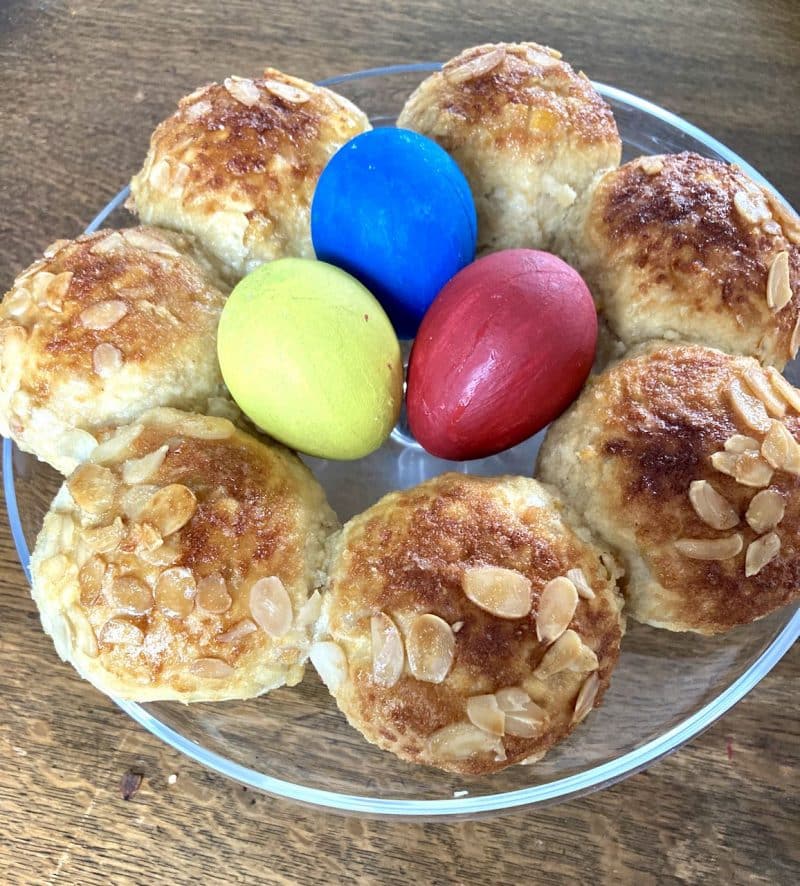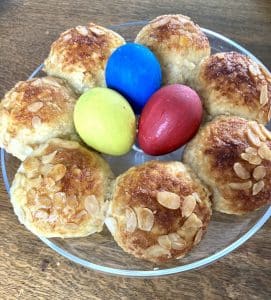Creating the perfect Italian Style Easter Bread
Many of the recipes for Italian Easter Bread I tried have been disappointing and dry. So I have created a recipe that is moist, tasty and improves with keeping. I have retained the almond topping found on many types of Italian Easter Bread.

If you look at photos of Italian Easter Bread, you’ll see brightly coloured eggs nestled in the bread. The idea is to place a raw egg with the dough and it will cook as the bread is baked. The trouble is, if you look at any dye kits for eggs, they assume that you’ll boil the eggs first. Also, most of our eggs are brown, so the colours will be muted. This is where Hobbycraft came to the rescue. They sell eggs made of paper mache that you can paint. A far better solution to my mind as I am not keen on eating boiled egg with bread! So that’s what I did for my version.
For the recipe, as you’ll be using the whole orange including the peel, you’ll need a small thin skinned orange (about 125 gr) that is unwaxed. These are quite easy to find in supermarkets and are either labelled unwaxed or organic. We’ll use the whole orange (minus the pips), so avoid a standard orange which will be waxed. A blood orange is ideal.
Why a fresh orange, candied orange and orange flower water? Each plays its part, the fresh orange for a moist dough (together with the Tangzhong a winning combination; the candied peel for texture and the orange flower water for extra flavour.

I am introducing you to Tangzhong. This is a way of sealing moisture into a dough. As you might guess, this is a Japanese technique which is used in Japanese Milk Bread recipe. The Easter Bread dough can also be made and popped in the fridge for completing the following day.

Italian Easter Bread Recipe
Equipment
- Saucepan
- Wooden spoon or whisk
- Food processor or blender
- Stand mixer
- Rolling pin
- Pastry Brush
- Plastic box with lid
Ingredients
- 250 grams Type OO Flour or bread flour
- 25 grams honey
- 7 grams dried yeast or 10 gr fresh yeast
- 1 unwaxed/organic orange approx 125 gr
- 1 egg 1 egg yolk
- 50 millilitres water
- 25 grams butter
- 1 teaspoon orange flower water optional
- 3 grams salt or a good pinch
For the Tangzhong
- 25 grams butter
- 25 grams flour
- 50 millilitres milk
For the Filling and Topping
- 50 grams mixed peel
- 1 egg white
- 30 grams ground almonds
- 30 grams caster sugar
- 30 grams Flaked almonds approx
- A little extra water
Instructions
Tangzhong
- Make the Tangzhong. In a small saucepan, melt the butter and add the flour and mix, then add the milk. Cook for a few minutes. This is similar to making a roux for a sauce. The mixture will be very thick. As it cools it softens and becomes pliable. Set aside and allow to cool down.

Prepare the orange
- Cut the orange into 6 or eight pieces and ensure you have taken out any pips. Put the whole orange including the peel into your food processor or blender and pulse to chop up finely. Put into a bowl for use later.

Make the dough
- Into the bowl of your stand mixer, add the flour, honey, yeast, salt, one whole egg and the egg yolk (you’ll use the egg white for the topping) and 50 ml water.
- Mix with the dough hook. It will be very stiff. Add the Tangzhong in small lumps. When mixed add the butter in small pieces. Add the orange flour water if using.
- Mix until the mixture reaches between 24 and 26°C. The time this will take will depend on how cold the ingredients were to start with.
- Now start adding the chopped orange a tablespoon at a time. To begin with, it will look as if the orange will not mix into the dough. Keep going it will! Mix until it is all absorbed. You’ll see flecks of the orange in the mixture.

- Cover and allow to rise for 1.5 hours. Alternatively, put the dough in the fridge to prove for a minimum of 3 hours or overnight.

- When shaped you will need to leave the buns for about an hour so preheat your oven to 190°C (375°F) at least 1/2 hour before you need to bake.
Topping
- Combine the sugar, ground almonds and egg white into a paste. Add water to make it a spreading consistency. Set aside.
Roll, fill and cut
- Once your dough has proved either in the fridge or overnight, roll it out to a rectangle about 1 cm thick. If you’ve not had the dough in the fridge, you’ll find it easier to work with if you pop it in for 15 minutes
- Sprinkle the candied peel evenly over the dough. Roll the dough up starting with the longest side.

- Cut into 70 gr pieces. When all are cut, gently gather each one into a ball shape. Then, roll each one to achieve a smooth finish.

- You’ll now place the buns in a circle with 1 cm between each one. I used seven in my circle, you’ll have a couple left over.

- Using a pastry brush, liberally spread the topping over the buns until very well covered. Sprinkle each one with flaked almonds
- Allow to prove for at least an hour at room temperature. You’ll see that the buns will have grown and will be almost touching.
Bake
- Bake for 15 minutes then check for colour, they should be a light golden brown. Bake longer if necessary.
- When cooled, add your coloured eggs as decoration.

Notes
More Italian Recipes
Stromboli – close cousin to a calzone
Egg Dyeing
As most of our eggs are brown, they do not seem to take colour well. I had a couple of eggs from a neighbour’s hens which were much lighter in colour so the yellow dye worked. However, the brown egg below which was dyed with yellow still looks brown!

The Mache eggs I used from Hobbycraft










2 thoughts on “Italian Style Easter Bread”